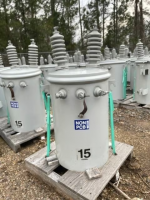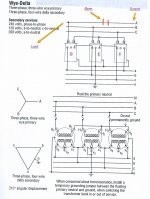I would like to hear the thoughts around the dangers of closed 120/240 systems. We know that the NEC does not allow a generator to back feed into a utility's system. What about the situation where a closed delta can feed back into a system if one of the primary phases is lost?
Here is a real situation. A transmission substation, owned by a transmission utility, receives it’s station service from the local utility. The service is a 12.47kV to 120/240V closed delta with one phase center tapped. This is done to achieve 120V. The three-phase 240V power is used mainly for large transformer pumps and fans.
These transformers can be 3 single phase pole top, or padmount transformers. The smallest ones would be (3) 50 KVA transformers. There is no three phase switching on the high side of these transformers, just typical fuses.
Closed delta systems can be seen in older parts of towns. However, in these cases it would seem that most of the switching is three phase, and if one phase was lost, there is so much connected load, that a fuse would quickly blow on the bank that would be back feeding attempting to pick up the load.
This transmission substation is in a rural location and is likely the only 3 phase load on the line. If one phase is lost, due to the local utility's single phase recloser, or a downed line, the transmission’s station service will feed back on the open phase. Isn’t this similar to a generator feeding back on the line? Is there something in the NEC that prohibits this arrangement?
Here is a real situation. A transmission substation, owned by a transmission utility, receives it’s station service from the local utility. The service is a 12.47kV to 120/240V closed delta with one phase center tapped. This is done to achieve 120V. The three-phase 240V power is used mainly for large transformer pumps and fans.
These transformers can be 3 single phase pole top, or padmount transformers. The smallest ones would be (3) 50 KVA transformers. There is no three phase switching on the high side of these transformers, just typical fuses.
Closed delta systems can be seen in older parts of towns. However, in these cases it would seem that most of the switching is three phase, and if one phase was lost, there is so much connected load, that a fuse would quickly blow on the bank that would be back feeding attempting to pick up the load.
This transmission substation is in a rural location and is likely the only 3 phase load on the line. If one phase is lost, due to the local utility's single phase recloser, or a downed line, the transmission’s station service will feed back on the open phase. Isn’t this similar to a generator feeding back on the line? Is there something in the NEC that prohibits this arrangement?


